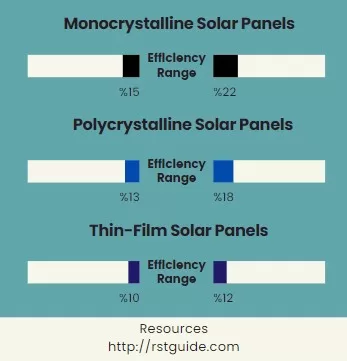Introduction to Solar Panel Efficiency
Solar energy is rapidly becoming one of the most popular sources of clean, renewable power. A crucial factor that determines the performance of a solar power system is the efficiency of its solar panels. Solar panel efficiency refers to the percentage of sunlight that a panel can convert into usable electricity, while solar panel performance is a measure of the panel’s effectiveness in converting sunlight into electricity under real-world conditions. We will explore the different types of solar panels, compare their efficiency through a solar panel efficiency comparison, and discuss factors that can affect their performance.
Factors Affecting Solar Panel Efficiency
Several factors can influence solar panel efficiency. Let’s take a closer look at some of the most common ones:
Temperature
Higher temperatures can negatively impact solar panel efficiency. As the temperature increases, the output of a solar panel declines, reducing its overall efficiency.
Angle of Incidence
The angle at which sunlight strikes a solar panel affects its efficiency. For optimal performance, the panel should be positioned to capture as much direct sunlight as possible.
Solar Panel Material
The type of material used in solar panels significantly impacts their efficiency. Some materials are better at converting sunlight into electricity than others in a solar panel efficiency comparison.
Age and Degradation
Solar panels degrade over time, which can lead to a gradual decline in efficiency. Proper maintenance and regular inspections can help minimize this degradation.

Types of Solar Panels
There are three primary types of solar panels available on the market: monocrystalline, polycrystalline, and thin-film. Each type has its own set of advantages and disadvantages.
Monocrystalline Solar Panels
Monocrystalline solar panels are made from single-crystal silicon cells. They have the highest efficiency among the three types, ranging from 15% to 22%. These panels are also known for their sleek, black appearance.
Polycrystalline Solar Panels
Polycrystalline solar panels consist of multiple silicon crystals. They have a slightly lower efficiency than monocrystalline panels, ranging from 13% to 18%. Polycrystalline panels typically have a blueish hue.
Thin-Film Solar Panels
Thin-film solar panels are made from a thin layer of semiconductor material. They have the lowest efficiency, ranging from 10% to 12%. However, thin-film panels are more flexible and lightweight compared to their crystalline counterparts.
Comparing the Efficiency of Solar Panel Types: Solar Panel Efficiency Comparison
Monocrystalline vs. Polycrystalline Solar Panels
Monocrystalline solar panels are generally more efficient than polycrystalline panels. The single-crystal structure of monocrystalline panels allows for a more efficient flow of electrons, leading to higher conversion rates. However, polycrystalline panels are typically less expensive and can be a cost-effective option for larger installations where space is not a constraint.
Monocrystalline vs. Thin-Film Solar Panels
Monocrystalline panels have a higher efficiency than thin-film panels. The difference in efficiency is primarily due to the higher-quality silicon used in monocrystalline panels. However, thin-film panels have some advantages, such as flexibility and lighter weight, which make them ideal for specific applications like portable solar chargers or curved surfaces.
Polycrystalline vs. Thin-Film Solar Panels
Polycrystalline panels are generally more efficient than thin-film panels in a solar panel efficiency comparison. While the efficiency gap is not as wide as with monocrystalline panels, polycrystalline panels still have a higher conversion rate. However, thin-film panels may be a more suitable choice for certain applications due to their flexibility and lightweight design.
Improving Solar Panel Efficiency
There are several ways to improve the efficiency of your solar panels. Some of these methods include:
- Regular cleaning to remove dust and debris.
- Properly angling the panels towards the sun.
- Installing a solar tracker to follow the sun throughout the day.
- Using microinverters or power optimizers to maximize the output of each panel.
- Regular maintenance and inspections to address any potential issues.
Future Technologies for Enhanced Efficiency
Researchers are continuously working on new technologies to improve solar panel efficiency. Some of the most promising advancements include:
- Perovskite solar cells, which have the potential to surpass the efficiency of traditional silicon-based solar cells.
- Multi-junction solar cells that can capture a broader spectrum of sunlight.
- Advanced materials and coatings to minimize energy losses and increase light absorption.
Conclusion
When comparing solar panel efficiency, it is essential to consider the type of solar panel, the factors affecting efficiency, and the specific needs of your project. Monocrystalline panels currently offer the highest efficiency, but polycrystalline and thin-film panels may be more suitable for certain applications. By understanding these factors and staying informed about future advancements in solar technology, you can make the best decision for your solar power system.
FAQs
What is the most efficient solar panel on the market?
Monocrystalline solar panels are currently the most efficient, with efficiency rates ranging from 15% to 22%.
How does temperature affect solar panel efficiency?
Higher temperatures can reduce the output of a solar panel, leading to decreased efficiency.
Can solar panel efficiency be improved over time?
Yes, regular maintenance, cleaning, and optimization techniques can help maintain and even improve solar panel efficiency.
What are some promising future technologies for solar panel efficiency?
Some promising future technologies include perovskite solar cells, multi-junction solar cells, and advanced materials and coatings.
Do I need to choose the most efficient solar panel for my project?
Not necessarily. It’s essential to consider factors such as cost, space constraints, and specific application requirements when selecting the most suitable solar panel type for your project.